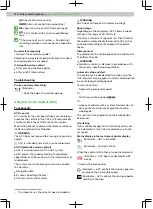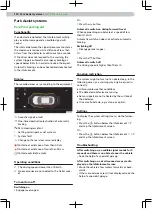
▶
Charging socket.
▶
Orange high-voltage cable and plug.
▶
High-voltage heating system.
The high-voltage battery is located under the ve-
hicle floor and is not accessible to users.
Charging of high-voltage battery
What you should be mindful of
WARNING
Danger of life-threatening electric shock, fire hazard,
danger of damage to vehicle.
▶
Follow the correct procedure for charging.
▶
Connect the charging cable to a power outlet that
is protected from both moisture and liquids.
▶
Only charge at correctly installed and undamaged
sockets and at a faultless electrical installation.
Have the sockets and electrical installations
checked at regular intervals.
▶
Never charge in potentially explosive areas. Com-
ponents of the charging cable can cause sparks
and thus ignite explosive vapours.
▶
Protect the charging plugs from moisture and liq-
uids.
▶
Do not carry out work on the vehicle while charg-
ing.
▶
Always remove the charging cable before starting
up the vehicle. Fit the protective cap and close the
battery charging flap.
▶
Never charge several vehicles at the same time at
the mains sockets of a fuse circuit.
▶
Observe the maximum charge capacity of the fuse
circuit used. If the charging cable is plugged into a
socket of the same circuit together with other
consumers, the circuit may be overloaded and the
charging process may be interrupted.
WARNING
▶
Never use damaged charging plugs or charging ca-
bles.
NOTICE
Long periods with the vehicle left standing with a
fully charged high-voltage battery for several
months can lead to a permanent reduction in the
charging capacity of the high-voltage battery.
▶
Avoid prolonged vehicle downtimes when the
high-voltage battery is at a high state of charge.
At very low and very high temperatures, there
may be restrictions when charging the high-voltage
battery. The charging time may be longer.
As the state of charge of the high-voltage battery
increases during charging, the ability of the high-
voltage battery to absorb energy decreases. This
slows down the charging process.
Overview
Charging socket and charging indicator
A
Charging socket (AC
alternating current)
B
Charging indicator
The charging process indicator also helps in illu-
minating the charging socket. White light glows for
instance after unlocking or parking the vehicle and
opening the battery flap.
Charging indicator
Plate on the interior of the battery flap
A
Green light glows - high-voltage battery is
charged, charging process is complete
B
Green light pulsating - high-voltage battery is
charging
C
Flashes green (about 1 minute after connecting
the charging cable) - time-delayed charging is
activated, but has not yet started
D
Flashes yellow - Selector lever of the automatic
transmission is not in position
E
Lights up yellow for several seconds - charging
plug inserted in charging socket is detected
Yellow light illuminates continuously - Charging
plug is plugged into the charging socket, but no
mains power was detected.
›
Have the power grid checked from which the
vehicle is being charged.
F
Red light illuminates - Charging plug is not
locked into the charging socket.
Disconnect the charging plug and insert it again
into the charging socket until it stops.
If the fault persists, seek the help of a specialist
company.
Flashes red - Fault in the vehicle's charging sys-
tem
130 High-voltage system ›
Charging of high-voltage battery
















































